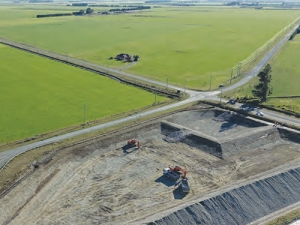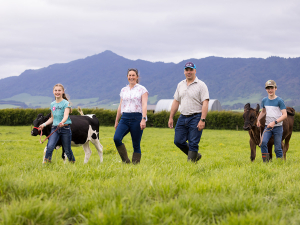Even its proponents admit the project sounds "absolutely barking".
The Hinds/Hekeao Managed Aquifer Recharge project consists essentially of a purpose-built "leaky pond" about 10km inland of State Highway 1 south of Ashburton, and a network of ground water and surface water monitoring sites fanning out across the plains almost to the coast.
With just a few finishing touches to be done, the project was officially opened early this month.
It is an area where, especially downstream on the coastal side of the highway, aquifer levels are low, springs and streams are drying up, and nitrate levels in the water from farm leaching are high.
The project aims to reverse that by recharging the aquifers with clean water from the Rangitata River via the Rangitata diversion race and the Valetta irrigation scheme, the water being an unused Ashburton District Council allocation.
The pond site includes a small sediment settling pond which overflows though a channel into the main recharge pond. The upper soil layers have been lifted away to expose the porous alluvial gravels and 27 clamshells; 6-7m deep holes backfilled with coarse stones will aid the drainage.
Leading the project, hydrologist Bob Bower has been involved in similar aquifer recharge schemes in his native US. He refers to limited trials here as early as the 1970s but believes the present trial is the first on this scale, "looking at a catchment scale issue, coming up with a pilot to test the concept, bringing the community along and helping to educate them about groundwater usage and water quality".
Bower says a similar project is at the consent stage in the Gisborne area. There, as in Canterbury, it is seen as important to bring together key partners iwi, councils and irrigators. "If you have all those people at the table the balance is there and you can achieve good things."
The Hinds/Hekeao pilot scheme has a goal of 15.8 million cubic metres of water – the equivalent of the 500L/second for which the scheme has consent – in the first year.
Bower says the plan is to get that amount of water through the system and see how the groundwater responds, take that information back to the governance groups and share it with the community.
"From then on it has a five-year consent and the idea is to keep running it, and raise groundwater levels and ideally help all the drains along the coast. Some of them were the best in Canterbury not long ago. The Parakanoi drain was fantastic for eel fishery and mahika kai gathering; it's now bone dry."
Bower says it is important to think of aquifers as reservoirs rather than rivers, holding huge volumes of water. "It's just very slowly moving towards the coast. So, when the water goes in, when it's used, how it affects the drains – that balance is what we're trying to do here with managed timing and approach."
ECan commissioner David Caygill told the official opening he vividly remembered the first time he heard about managed aquifer recharge, at a presentation that left ECan "shaking their heads" and thinking someone "had been smoking stuff". "We were a long, long way away from being persuaded that this made any sense whatsoever."
But he acknowledged the enthusiasm of Bob Bower and the support of the Ashburton zone committee in recognising the worth of the idea.
"It's a trial designed to find out what happens rather than to prove particular preconceptions. [The] trial will help address some nitrate issues and some other issues."
Peter Lowe, who farms in a downstream area classified as a nutrient red zone but is now likely to benefit from the trial, says local farmers welcome the plan.
"Two years ago, the common reaction you'd get was, 'you're going to do what?' But in the last six months the reaction has been, 'when are you going to start?'."
Replenishment of groundwater has become contentious recently with the news that the Ashburton District Council is selling a section in its business estate, complete with the right to take 45L of bore water/second, to a company planning to bottle it for export.
District mayor Angus McKay, who also attended the Hinds/Hekeao MAR opening, says the two schemes are separate, since the bottling site is north of the Ashburton River. However, the consents will require the council to replenish that area also, at a rate of 60L/second. A shingle pit has been chosen which would be landscaped with native plants as the insertion point and fed by an existing race taking water from the Ashburton River.
McKay emphasises that replenishment – unmanaged – has gone on in Canterbury for decades.
He says the Rangitata diversion race commissioned in the 1940s, and its associated Mayfield/Hinds and Valetta schemes, all originally used border dyke systems.
"They found, particularly around Hinds, that within six weeks of the water starting to flow down the dykes in the summer season, the shallow wells rose to above ground level. That was recharge, way back, years ago."
More efficient and less wasteful irrigation systems have since caused wells and streams to dry up, says McKay.
"The Ashburton zone committee of the Canterbury Water Management Strategy wants to reinvigorate the environment of the drains and this is one way they think they can do it, because it used to happen years ago."
Canterbury medical officer of health Dr Alistair Humphrey told guests at the opening that nitrates in groundwater are "like the canary in the mine".
Humphrey has warned in the past of the health effects of high nitrate levels in drinking water: bottle-fed babies in particular can suffer from a condition which interferes with oxygen transport in the blood.
He says at least a quarter of the bores recently sampled in the area had nitrate levels above the recommended maximum and another three-quarters showed levels more than half the maximum.
But he is confident that nitrate levels, particularly in the shallower bores, will start to fall "pretty quickly" as the pilot gets underway.
















